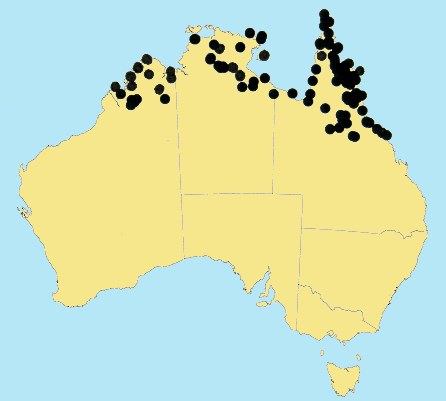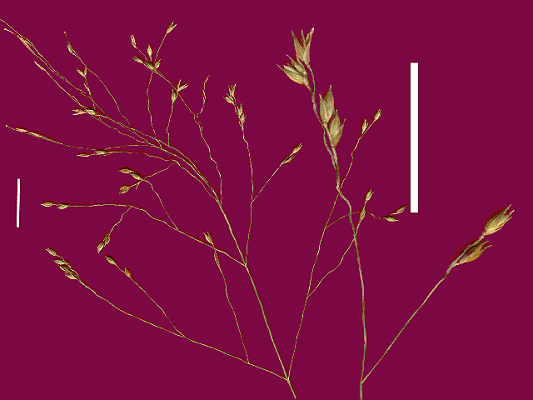Panicum seminudum Domin. Biblioth.
Bot. 85: 320 (1915).
Classification. (GPWG 2001) : Subfamily
Panicoideae. Paniceae.
Type of Basionym or
Protologue Information: HT: Domin 1/1910, Jan 1910, Australia:
Queensland (PR; IT: K (fragm.)).
Key references
(books and floras): [2002] D.Sharp & B.K.Simon, AusGrass, Grasses of
Australia.
Habit. Annual.
Rhizomes absent. Stolons absent. Culms erect, 40–90 cm tall, 2–5 -noded.
Mid-culm internodes glabrous. Mid-culm nodes glabrous. Lateral branches
sparsely branched. Leaf-sheaths glabrous on surface or hairy. Leaf-sheath
auricles absent. Ligule a fringed membrane, a ciliate membrane, 0.8–1.5 mm
long. Leaf-blades linear, 4–30 cm long, 3–9 mm wide. Leaf-blade surface smooth
or scabrous, glabrous or indumented.
Inflorescence.
Inflorescence compound, a panicle. Panicle ovate, 15–30 cm long, evenly
furnished or with spikelets clustered towards branch tips.
Spikelets.
Spikelets pedicelled. Fertile spikelets 2-flowered, the lower floret barren
(rarely male), the upper fertile, comprising 1 basal sterile florets,
comprising 1 fertile floret(s), without rachilla extension, lanceolate or
elliptic, dorsally compressed, 3.1–3.7 mm long. Rhachilla internodes elongated
between glumes.
Glumes. Glumes
thinner than fertile lemma. Lower glume lanceolate or ovate, membranous,
without keels, 3–5 -nerved. Lower glume apex muticous or mucronate. Upper glume
lanceolate or ovate, 2.8–3.5 mm long, membranous, without keels, 7 -nerved. Florets.
Basal sterile florets 1, barren, without significant palea. Lemma of lower sterile
floret 100 % of length of spikelet, membranous, 5 -nerved, muticous.
Fertile lemma 1.9–2.2
mm long, without keel. Lemma apex muticous. Anthers 3.
Continental
Distribution: Tropical Asia and Australasia.
Australian
Distribution: Western Australia, Northern Territory, Queensland.
Western Australia:
Gardner. Northern Territory: Darwin & Gulf. Queensland:
Burke, Cook, North Kennedy.
Notes.
A variable species and more collections are needed before the various forms can
be defined. Specimens with hairy leaves are named P. seminudum var. cairnsianum,
however, there seems to be a gradual transition between the hairy and glabrous
forms.
Native. Occurs across
the tropics and subtropics of northern Australia and into New Guinea. New
Guinea. In tropical and subtropical rain forests and tropical and subtropical
sub-humid woodlands. Flowers Mar.-July.
Infra-specific taxa: var. seminudum, var. cairnsianum.
Leaves glabrous P. seminudum var. seminudum
Leaves hairy P. seminudum var. cairnsianum





